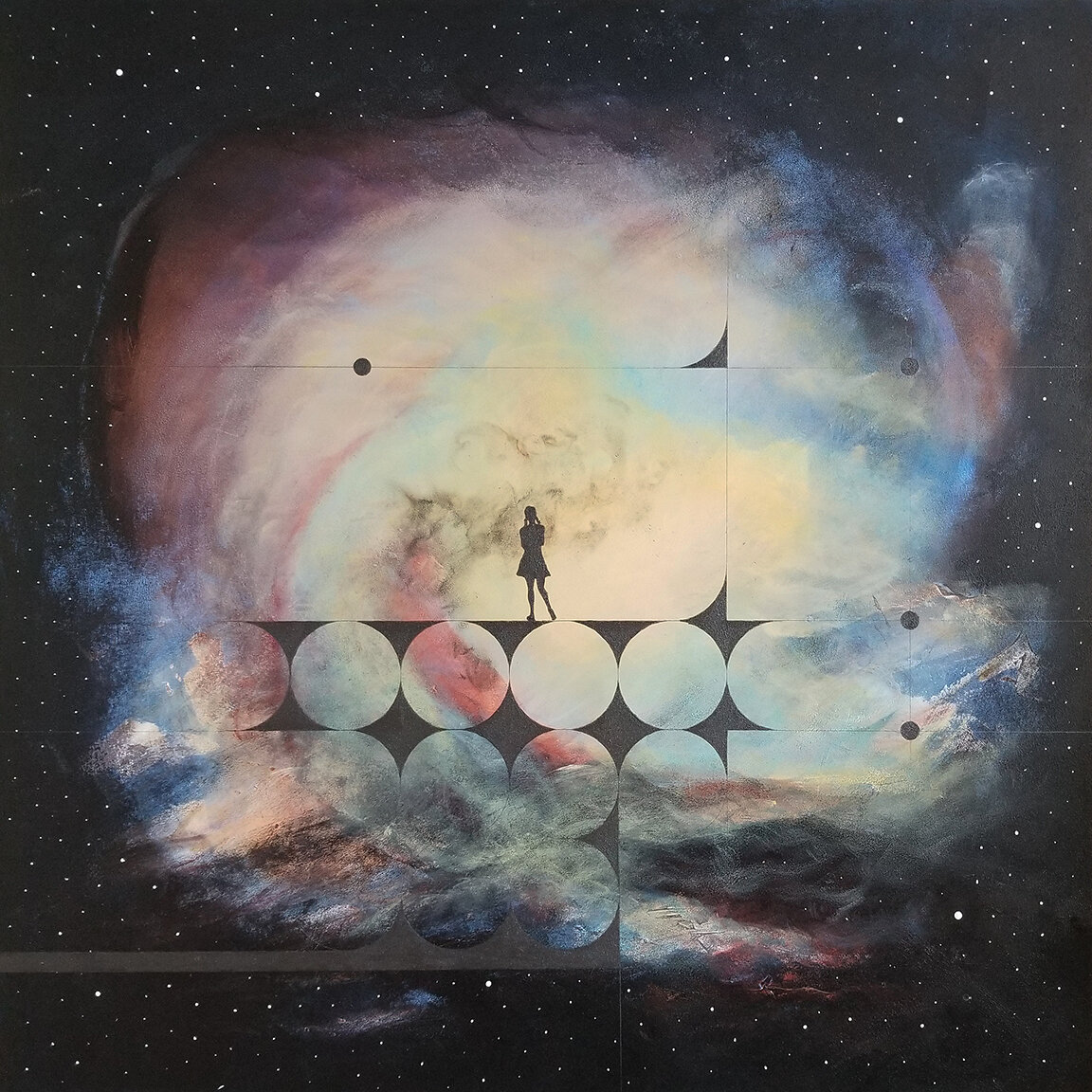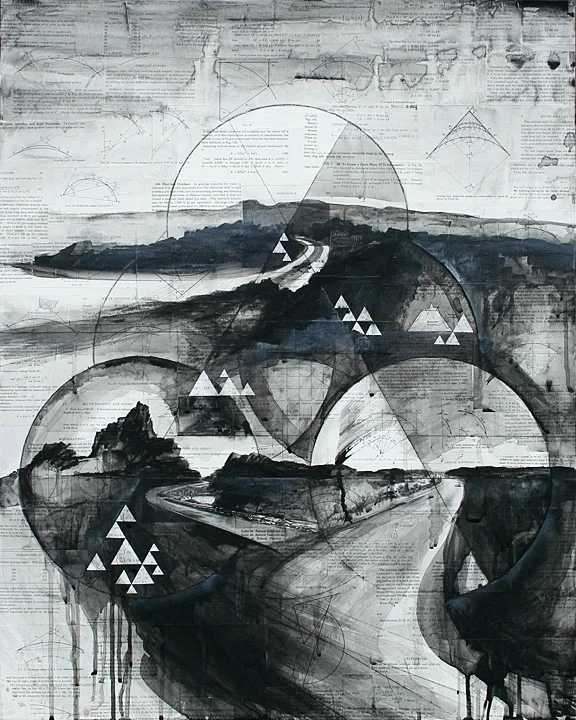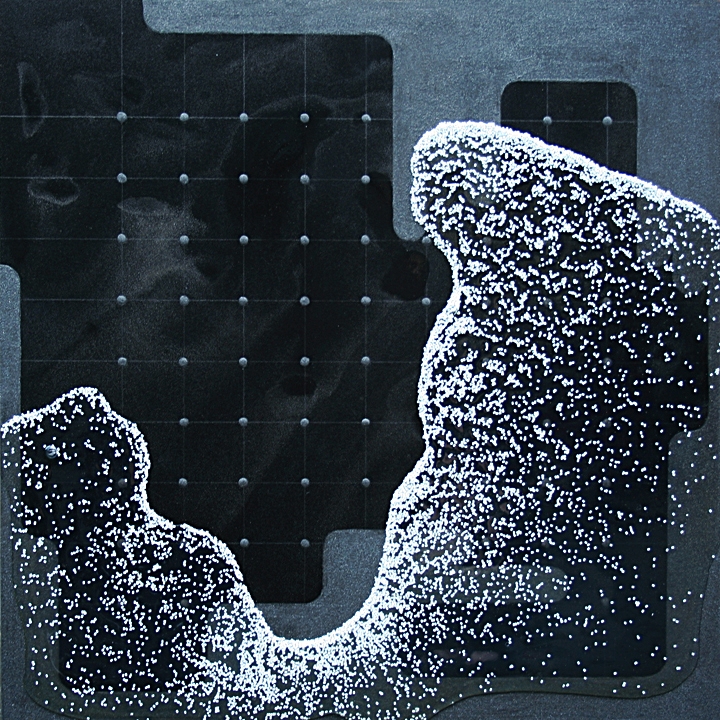The entirety of my direct experience with AM radio has occurred at night, in a car, on a highway. During one of these drives I was told, while listening to a man explain how he copes with his ability to read minds, that AM radio signals behave differently during daytime and nighttime.
The science of AM radio functioning struck me as somehow poignant. AM radio crouches low and weak during the glare of day, but at night unfolds humble wings and reaches across great distances. From Wiki:
During the day, AM signals travel by groundwave, diffracting around the curve of the earth over a distance up to a few hundred miles (or kilometers) from the signal transmitter. However, after sunset, changes in the ionosphere cause AM signals to travel by skywave, enabling AM radio stations to be heard much farther from their point of origin than is normal during the day.
I am also moved by this:
AM radio signals can be severely disrupted in large urban centres by metal structures, tall buildings and sources of radio frequency interference (RFI) and electrical noise, such as electrical motors, fluorescent lights, or lightning. Wiki.
AM radio is driving through the middle of nowhere in the dark listening to the fringes of human endeavor being put forth with a no gloss earnestness and meandering passion. We use AM waves to project into the clear, dark everywhere/anywhere our most basic, contentious, awkward human endeavors–extreme partisan politics, religion, the supernatural, ufos, as well as, a few songs that you will never hear again anywhere else.
The oddly hollow tone of AM radio further adds a layer of remoteness that relates to the cold, dark hum of deep space, with its vast distances between stars, planets, galaxies.
Oh, I also discovered that I happen to share a birthday with AM radio:
AM radio began with the first, experimental broadcast on [December 24th] of 1906 by Canadian experimenter Reginald Fessenden, and was used for small-scale voice and music broadcasts up until World War I.

![[ominous music playing]](https://images.squarespace-cdn.com/content/v1/5a26d10f8dd04125bfebfe95/1696208305047-YGVQKZ6SP6OYJPAHKKXP/Ominous_web.jpg)






















![Note to Self [DETAIL]](https://images.squarespace-cdn.com/content/v1/5a26d10f8dd04125bfebfe95/1726369198705-S3US1JMKDUGB8AQAZKCC/nostalgia_det03_web.jpg)
![Note to Self [DETAIL]](https://images.squarespace-cdn.com/content/v1/5a26d10f8dd04125bfebfe95/1726369203101-E98UC0A39VP8V50U84II/nostalgia_det02_web.jpg)
![Note to Self [DETAIL]](https://images.squarespace-cdn.com/content/v1/5a26d10f8dd04125bfebfe95/1726369212744-TCES6U30LB7WJ7DSDEP9/nostalgia_det01_web.jpg)
![[ominous music playing] [detail]](https://images.squarespace-cdn.com/content/v1/5a26d10f8dd04125bfebfe95/1696206548590-YS8I6AK9HF4GUIAHG6LV/Ominous_det01_web.jpg)
![[ominous music playing] [detail]](https://images.squarespace-cdn.com/content/v1/5a26d10f8dd04125bfebfe95/1696208326343-32S5FHTNEIYNQL2QDRA1/Ominous_det02_web.jpg)
![[ominous music playing] [detail]](https://images.squarespace-cdn.com/content/v1/5a26d10f8dd04125bfebfe95/1696206554988-WU34LTRLI9O5EC0GM37U/Ominous_det03_web.jpg)
![[ominous music playing] [detail]](https://images.squarespace-cdn.com/content/v1/5a26d10f8dd04125bfebfe95/1696206560115-0KLJ7G8LLFIRQIV2LQ7O/Ominous_det04_web.jpg)
![[ominous music playing] [detail]](https://images.squarespace-cdn.com/content/v1/5a26d10f8dd04125bfebfe95/1696206560990-N06DCLQAPS6LRNRNYK8W/Ominous_det05_web.jpg)

![The Sun Also Rises [detail]](https://images.squarespace-cdn.com/content/v1/5a26d10f8dd04125bfebfe95/1696208347637-125JOZVKWJZ6R94XU7R0/SunAlsoRises_det03_web.jpg)
![The Sun Also Rises [detail]](https://images.squarespace-cdn.com/content/v1/5a26d10f8dd04125bfebfe95/1696208365209-VM3O2FWY065OP1WRGH3G/SunAlsoRises_det02_web.jpg)
![The Sun Also Rises [detail]](https://images.squarespace-cdn.com/content/v1/5a26d10f8dd04125bfebfe95/1696206485949-O4U076MPA5M39VJGIDUJ/SunAlsoRises_det01_web.jpg)

![The Open Door [DETAIL]](https://images.squarespace-cdn.com/content/v1/5a26d10f8dd04125bfebfe95/1726362485589-7C7L41X4XBKR2BEYTAH3/Door_det04_web.jpg)
![The Open Door [DETAIL]](https://images.squarespace-cdn.com/content/v1/5a26d10f8dd04125bfebfe95/1726362481556-JZA780E716GL5QGBA8MN/Door_det03_web.jpg)
![The Open Door [DETAIL]](https://images.squarespace-cdn.com/content/v1/5a26d10f8dd04125bfebfe95/1726362479963-SL6YJP6VNKMQDL061RSW/Door_det02_web.jpg)
![The Open Door [DETAIL]](https://images.squarespace-cdn.com/content/v1/5a26d10f8dd04125bfebfe95/1726362472883-6V66MSNVGLTWKZDRG0IF/Door_det01_web.jpg)

![Beyond the Pines [detail]](https://images.squarespace-cdn.com/content/v1/5a26d10f8dd04125bfebfe95/1696206627487-X6UG1J8HRNSAICGQ343U/Beyond_det04_web.jpg)
![Beyond the Pines [detail]](https://images.squarespace-cdn.com/content/v1/5a26d10f8dd04125bfebfe95/1696206636221-9OZITLZ1ES9VI92KMK44/Beyond_det01_web.jpg)
![Beyond the Pines [detail]](https://images.squarespace-cdn.com/content/v1/5a26d10f8dd04125bfebfe95/1696206632525-Z74DXN94IFD9ZEZUDLQ5/Beyond_det02_web.jpg)
![Beyond the Pines [detail]](https://images.squarespace-cdn.com/content/v1/5a26d10f8dd04125bfebfe95/1696206632527-ON58EGFR8CFBS61J5CFS/Beyond_det03_web.jpg)

![Pattern Recognition [detail]](https://images.squarespace-cdn.com/content/v1/5a26d10f8dd04125bfebfe95/1696208523344-A6FN87NPI6338JB35BKI/PatternRecog_det03_web.jpg)
![Pattern Recognition [detail]](https://images.squarespace-cdn.com/content/v1/5a26d10f8dd04125bfebfe95/1696208550600-T3FCYBYNLGS94V7QOJKB/PatternRecog_det02_web.jpg)
![Pattern Recognition [detail]](https://images.squarespace-cdn.com/content/v1/5a26d10f8dd04125bfebfe95/1696208578270-YRNUVFYR9L8U4VR7A0U9/PatternRecog_det01_web.jpg)

![Reckless Attention [detail view]](https://images.squarespace-cdn.com/content/v1/5a26d10f8dd04125bfebfe95/1569613399554-619AK3F74BLGC0E77870/det04.jpg)
![Reckless Attention [detail view]](https://images.squarespace-cdn.com/content/v1/5a26d10f8dd04125bfebfe95/1569613421388-5LYJT6FC2AJOHBIQD2BS/det02.jpg)


![Nixie, Moments Before Sleep [detail view]](https://images.squarespace-cdn.com/content/v1/5a26d10f8dd04125bfebfe95/1581008957469-FJL8YBFYRUH99L7E065D/image-asset.jpeg)
![Nixie, Moments Before Sleep [detail view]](https://images.squarespace-cdn.com/content/v1/5a26d10f8dd04125bfebfe95/1581008678112-RL0Y6VFVTTQEF6PFFHJF/image-asset.jpeg)
![Nixie, Moments Before Sleep [detail view]](https://images.squarespace-cdn.com/content/v1/5a26d10f8dd04125bfebfe95/1581008983949-DAF72NUKIC9ALW020MXG/nixie_det03.jpg)

![The Seventh Mountain Peak [detail view]](https://images.squarespace-cdn.com/content/v1/5a26d10f8dd04125bfebfe95/1569961514440-S042LXCTUNXPTYUFC9HZ/weather_det05.jpg)


![The Thrill of Constant Motion [detail view]](https://images.squarespace-cdn.com/content/v1/5a26d10f8dd04125bfebfe95/1521213215819-W69CTPQ841OI46Q1L6LE/cft_runrabbitrun_det02.jpg)
![The Thrill of Constant Motion [detail view]](https://images.squarespace-cdn.com/content/v1/5a26d10f8dd04125bfebfe95/1521213294737-F44ZC76HAVFIYTZ4ZRBX/cft_runrabbitrun.det01.jpg)

![A Place for Wild Things [detail view]](https://images.squarespace-cdn.com/content/v1/5a26d10f8dd04125bfebfe95/1589916016633-DBS2QEKN84A2O2QJEL8P/wildthings_det01.jpg)

![She Put the Cup To Her Lips [detail view]](https://images.squarespace-cdn.com/content/v1/5a26d10f8dd04125bfebfe95/1512504984597-REOYHN865NF9CJLPKWH9/if_pool_det01.jpg)

![You Didn't Mean To Do That, Did You [detail view]](https://images.squarespace-cdn.com/content/v1/5a26d10f8dd04125bfebfe95/1512504939887-EJ2I7RUKQ8UTTEULHCFD/cft_YouDidntMeanThat_det01.jpg)

![The Owl of Iron Island [DETAIL]](https://images.squarespace-cdn.com/content/v1/5a26d10f8dd04125bfebfe95/1726362756465-II7FM9U6EWEM7QVR5G9U/web_Iron+Island_det02.jpg)
![The Owl of Iron Island [DETAIL]](https://images.squarespace-cdn.com/content/v1/5a26d10f8dd04125bfebfe95/1726362764571-GKM9YQZNHK32YL3C0M30/web_Iron+Island_det03.jpg)
![The Owl of Iron Island [DETAIL]](https://images.squarespace-cdn.com/content/v1/5a26d10f8dd04125bfebfe95/1726362764570-9QECUD3EMZ8JLG2ESL56/web_Iron+Island_det04.jpg)
![The Owl of Iron Island [DETAIL]](https://images.squarespace-cdn.com/content/v1/5a26d10f8dd04125bfebfe95/1726362756465-GB8TJV9FOKV90DTM5VAY/web_Iron+Island_det01.jpg)

![The Once and Future [DETAIL]](https://images.squarespace-cdn.com/content/v1/5a26d10f8dd04125bfebfe95/1726362815551-R2IOBQNEQ5HISP51VAWV/web_TheOnceFuture_det03.jpg)
![The Once and Future [DETAIL]](https://images.squarespace-cdn.com/content/v1/5a26d10f8dd04125bfebfe95/1726362819066-XM3Z6THYGFKN9P3JXZLM/web_TheOnceFuture_det04.jpg)
![The Once and Future [DETAIL]](https://images.squarespace-cdn.com/content/v1/5a26d10f8dd04125bfebfe95/1726362811678-RW7C9KOKFB0065INXDJT/web_TheOnceFuture_det02.jpg)
![The Once and Future [DETAIL]](https://images.squarespace-cdn.com/content/v1/5a26d10f8dd04125bfebfe95/1726362813338-N4063Y16D33635LKELHK/web_TheOnceFuture_det01.jpg)

![Beyond Mountains & Moons [detail]](https://images.squarespace-cdn.com/content/v1/5a26d10f8dd04125bfebfe95/1726362870640-M8MPGM9SB9CNDACLE5KK/winter_web_Det01.jpg)
![Beyond Mountains & Moons [detail]](https://images.squarespace-cdn.com/content/v1/5a26d10f8dd04125bfebfe95/1726362874203-5HWD9T69EVE3KWRWEEAQ/winter_web_det02.jpg)
![Beyond Mountains & Moons [detail]](https://images.squarespace-cdn.com/content/v1/5a26d10f8dd04125bfebfe95/1726362876906-X9NTAGCQRNJFYKY5M4TG/winter_web_det03.jpg)
![Beyond Mountains & Moons [detail]](https://images.squarespace-cdn.com/content/v1/5a26d10f8dd04125bfebfe95/1726362882621-RNTHOZDOZRAP7K9LKLAX/winter_web_det06.jpg)
![Beyond Mountains & Moons [detail]](https://images.squarespace-cdn.com/content/v1/5a26d10f8dd04125bfebfe95/1726362879785-O4HG34QUJVV5V5O8TCSX/winter_web_det04.jpg)

![Wandering at the Threshold [detail]](https://images.squarespace-cdn.com/content/v1/5a26d10f8dd04125bfebfe95/1726362832090-GKU329JL0L2W9TN20NTS/web_TableTop_det01.jpg)
![Wandering at the Threshold [detail]](https://images.squarespace-cdn.com/content/v1/5a26d10f8dd04125bfebfe95/1726362835319-8CMAMZOCSJJ80BDTXFY0/web_TableTop_det03.jpg)
![Wandering at the Threshold [detail]](https://images.squarespace-cdn.com/content/v1/5a26d10f8dd04125bfebfe95/1726362838094-0KIUPN118SU3Y753QXJO/web_TableTop_det04.jpg)


![At the Gate of the Frog Prince [detail]](https://images.squarespace-cdn.com/content/v1/5a26d10f8dd04125bfebfe95/1726886261291-K02E2I73KHUO6CQCS3FI/web_FrogGate_det01.jpg)
![At the Gate of the Frog Prince [detail]](https://images.squarespace-cdn.com/content/v1/5a26d10f8dd04125bfebfe95/1726886310151-EZITRKOBIAWVRGU1ZG9N/web_FrogGate_det02.jpg)
![At the Gate of the Frog Prince [detail]](https://images.squarespace-cdn.com/content/v1/5a26d10f8dd04125bfebfe95/1726886316472-2124EC9SM5BJ4DBI35QW/web_FrogGate_det03.jpg)

![Hey, Where's That Dude Going? [detail view]](https://images.squarespace-cdn.com/content/v1/5a26d10f8dd04125bfebfe95/1512578150340-FY6QU5L9WD95BHRHFD09/dist_dudes_det01.jpg)

![Central Control [detail view]](https://images.squarespace-cdn.com/content/v1/5a26d10f8dd04125bfebfe95/1512578345988-Y1Y6WNGOPEUD3GP8APOZ/dist_centralcontrol_det01.jpg)
![Central Control [detail view]](https://images.squarespace-cdn.com/content/v1/5a26d10f8dd04125bfebfe95/1512578402360-JINDBK9UMOTZMHDTWW0B/dist_centralcontrol_det03.jpg)

![Closed Door Meeting [detail view]](https://images.squarespace-cdn.com/content/v1/5a26d10f8dd04125bfebfe95/1512578530204-EHYYKCK4JA3BEQIAQN07/dist_closeddoor_det01.jpg)
![Closed Door Meeting [detail view]](https://images.squarespace-cdn.com/content/v1/5a26d10f8dd04125bfebfe95/1512578575293-7X2300SC1P19ME8NJQDV/dist_closeddoor_det03.jpg)

![Mixer [detail view]](https://images.squarespace-cdn.com/content/v1/5a26d10f8dd04125bfebfe95/1512578760672-I4O39HLBJDPQ3IBB22CQ/dist_mixer_det01.jpg)

![The Proposal [detail view]](https://images.squarespace-cdn.com/content/v1/5a26d10f8dd04125bfebfe95/1512578946264-WCB0R949ES53MTRO7JMP/dist_proposal_det01a.jpg)

![Downtime [detail view]](https://images.squarespace-cdn.com/content/v1/5a26d10f8dd04125bfebfe95/1512579068539-3L1K1ZOYY2WC2O0V2N0Z/dist_quarters_det02.jpg)

![The Candidate [detail view]](https://images.squarespace-cdn.com/content/v1/5a26d10f8dd04125bfebfe95/1512579167807-R60Y0SGK03V6CAZRYBGP/dist_thecandidate_det02.jpg)
![The Candidate [detail view]](https://images.squarespace-cdn.com/content/v1/5a26d10f8dd04125bfebfe95/1512579211564-OOP71S671IG244KF6O28/dist_thecandidate_det03.jpg)

![The Symposium [detail view]](https://images.squarespace-cdn.com/content/v1/5a26d10f8dd04125bfebfe95/1512579320655-WKQ0L3X87UIS8UQD5SLN/dist_thesymposium_det01.jpg)
![The Symposium [detail view]](https://images.squarespace-cdn.com/content/v1/5a26d10f8dd04125bfebfe95/1512579357936-TDNIK5ERS0NEWYZ8X8AS/dist_thesymposium_det02.jpg)

![Headquarters [detail view]](https://images.squarespace-cdn.com/content/v1/5a26d10f8dd04125bfebfe95/1512579461732-GGNZYA4OELW629NSJF2N/24_distheadquartersdet02.jpg)
![Headquarters [detail view]](https://images.squarespace-cdn.com/content/v1/5a26d10f8dd04125bfebfe95/1512579512527-GN8WV7YXZ7IHNHHE2NMW/24_distheadquartersdet01.jpg)

![The Comfort Effect of Change [detail view]](https://images.squarespace-cdn.com/content/v1/5a26d10f8dd04125bfebfe95/1512660367238-FD8RHJQ21VH50H6X7N1C/thecomforteffect_det03.jpg)

![To the Sun [detail view]](https://images.squarespace-cdn.com/content/v1/5a26d10f8dd04125bfebfe95/1512660431538-4TPAFITIPS81D359FG7B/tothesun_det03.jpg)

![Sight Distance [detail view]](https://images.squarespace-cdn.com/content/v1/5a26d10f8dd04125bfebfe95/1512660496367-51WKN2548TLJCJAGI5D5/sightdistance_det02.jpg)

![Systems [detail view]](https://images.squarespace-cdn.com/content/v1/5a26d10f8dd04125bfebfe95/1512757867372-K6RIPMG0LAZ558N4KWL2/systems_counsellangley_detail.jpg)

![All These Constellations We Constructed [detail]](https://images.squarespace-cdn.com/content/v1/5a26d10f8dd04125bfebfe95/1598817253492-I0YGRZ2LQJJ7A8V0U741/constella_det01.jpg)
![All These Constellations We Constructed [detail]](https://images.squarespace-cdn.com/content/v1/5a26d10f8dd04125bfebfe95/1598817241542-8UY6GE3RKCGPSBQKWEIV/constella_det03.jpg)
![All These Constellations We Constructed [detail]](https://images.squarespace-cdn.com/content/v1/5a26d10f8dd04125bfebfe95/1598817249254-MWAVURVXJBBFPR1AVUQS/constella_det02.jpg)

![A Time to Be a Star/A Time to Gaze at Stars [detail]](https://images.squarespace-cdn.com/content/v1/5a26d10f8dd04125bfebfe95/1589926532292-R18SNZRWGQ0546T9X3IU/stars_det01.jpg)
![A Time to Be a Star/A Time to Gaze at Stars [detail]](https://images.squarespace-cdn.com/content/v1/5a26d10f8dd04125bfebfe95/1589926437785-4E4HK0F9VT7F7JNBSSU5/stars_det02.jpg)



![Midnight City [detail]](https://images.squarespace-cdn.com/content/v1/5a26d10f8dd04125bfebfe95/1512657150252-L5ZZK5PGKAMGZD4YJ1OO/24273633_10215016212697918_3687679344614266120_o.jpg)

![I Love Your Precious Heart [detail]](https://images.squarespace-cdn.com/content/v1/5a26d10f8dd04125bfebfe95/1593280597716-OJJ3SOJVEGHHUT4XWS1M/heart_det02.jpg)
![I Love Your Precious Heart [detail]](https://images.squarespace-cdn.com/content/v1/5a26d10f8dd04125bfebfe95/1593280579215-KODZ1BOGCNCME5D9JVOS/heart_det01.jpg)

![Ice Asteroid Warehouse District [detail]](https://images.squarespace-cdn.com/content/v1/5a26d10f8dd04125bfebfe95/1512657056894-R86LNCG58W9WAH0E33YZ/if_warehousedistrict_det02.jpg)

![Privacy Archive [detail]](https://images.squarespace-cdn.com/content/v1/5a26d10f8dd04125bfebfe95/1567702650254-JYMKP3DZ17DOCQU8ONQ6/det01.jpg)
![Privacy Archive [detail]](https://images.squarespace-cdn.com/content/v1/5a26d10f8dd04125bfebfe95/1567702583794-XA2YEXYJ5ADJ732L0H9M/det05.jpg)
![Privacy Archive [detail]](https://images.squarespace-cdn.com/content/v1/5a26d10f8dd04125bfebfe95/1567702624853-PWVUFY3VRZMNIYAK7F2K/det04.jpg)

![Interplanetary Travel (Jealous of Microbes) [detail]](https://images.squarespace-cdn.com/content/v1/5a26d10f8dd04125bfebfe95/1521321747740-EZHAVHCH8GVJBJSJKIFI/if_interplanetary_det01.jpg)



![Sunset Projector [detail]](https://images.squarespace-cdn.com/content/v1/5a26d10f8dd04125bfebfe95/1589926752532-L4I5CD9PQS4MG13VQCC8/sunsetprojector03.jpg)
![Sunset Projector [detail]](https://images.squarespace-cdn.com/content/v1/5a26d10f8dd04125bfebfe95/1589926729727-ZILNQGTTFXOR67AYVKU9/sunsetprojector01.jpg)

![Arcade [detail]](https://images.squarespace-cdn.com/content/v1/5a26d10f8dd04125bfebfe95/1589925868789-7ZN51KH9X8YGJ5PHPWRZ/arcade_det01.jpg)
![Arcade [detail]](https://images.squarespace-cdn.com/content/v1/5a26d10f8dd04125bfebfe95/1589925874045-78MC16SN6XLN116K2RAZ/arcade_det03.jpg)
![Arcade [detail]](https://images.squarespace-cdn.com/content/v1/5a26d10f8dd04125bfebfe95/1589925869027-0C9M5JQJ51URMLMX8B5A/arcade_det02.jpg)



![Forge [detail]](https://images.squarespace-cdn.com/content/v1/5a26d10f8dd04125bfebfe95/1512657114340-AGZ3BTN7GMKW9GNDNE45/if_forge_det01.jpg)

![Dusk [detail view]](https://images.squarespace-cdn.com/content/v1/5a26d10f8dd04125bfebfe95/1512663449995-BN0GZ6MNAOELOCLFRVXO/nights_dusk_det01.jpg)
![Dusk [detail view]](https://images.squarespace-cdn.com/content/v1/5a26d10f8dd04125bfebfe95/1512663482555-MEFCCUOT2Z783V437Z2E/nights_dusk_det02.jpg)

![Arrivals [detail view]](https://images.squarespace-cdn.com/content/v1/5a26d10f8dd04125bfebfe95/1512663355968-Z5RZ8JSYGVE1S5TEERQS/nights_arrivals_det02.jpg)

![Far North II [detail view]](https://images.squarespace-cdn.com/content/v1/5a26d10f8dd04125bfebfe95/1512660866388-ODMJYJ8M6Q6VBZ9WG7QS/nights_barrow_det02.jpg)
![Far North II [detail view]](https://images.squarespace-cdn.com/content/v1/5a26d10f8dd04125bfebfe95/1512660892945-0YY746LBHC83Z6XPSSVS/nights_barrow_det01.jpg)

![2AM [detail view]](https://images.squarespace-cdn.com/content/v1/5a26d10f8dd04125bfebfe95/1512505622188-BXD5LU0ZRU5XN9XDMYUE/nights_2am_det01.jpg)
![2AM [detail view]](https://images.squarespace-cdn.com/content/v1/5a26d10f8dd04125bfebfe95/1512506805092-VOQCXZ74PQNNJP2Z4DCQ/nights_2am_det02.jpg)
![2AM [detail view]](https://images.squarespace-cdn.com/content/v1/5a26d10f8dd04125bfebfe95/1512506839300-PJQAGLTGO73AOVMCNFB3/nights_2am_det04.jpg)

![Further On Into the Evening [detail view]](https://images.squarespace-cdn.com/content/v1/5a26d10f8dd04125bfebfe95/1512505660236-R0U44HF1OU2ZS74W6UAF/nights_furtherintoeve_det01.jpg)
![Further On Into the Evening [detail view]](https://images.squarespace-cdn.com/content/v1/5a26d10f8dd04125bfebfe95/1512505662425-AC5OJIW9LFXAKSMTNU4S/nights_furtherintoeve_det02.jpg)

![Sunset (Highlands With Trestle) [detail view]](https://images.squarespace-cdn.com/content/v1/5a26d10f8dd04125bfebfe95/1512663790500-BS02L7K2AAQOIND8HBJ1/nights_highlands_det01.jpg)
![Sunset (Highlands With Trestle) [detail view]](https://images.squarespace-cdn.com/content/v1/5a26d10f8dd04125bfebfe95/1512663808765-BGZEGHA7NCTULTK4L0DK/nights_highlands_det02.jpg)

![Data Collection (Midnight) [detail view]](https://images.squarespace-cdn.com/content/v1/5a26d10f8dd04125bfebfe95/1512663642848-98F8N5Y3NO35JN9D4NVJ/nights_datacollection_det01.jpg)
![Data Collection (Midnight) [detail view]](https://images.squarespace-cdn.com/content/v1/5a26d10f8dd04125bfebfe95/1512663683147-SEA4CA0CMTLYB35ZTZAX/nights_datacollection_det03.jpg)
![Data Collection (Midnight) [detail view]](https://images.squarespace-cdn.com/content/v1/5a26d10f8dd04125bfebfe95/1512663716737-RGDYIHT5TTEANHZ6JHOR/nights_datacollection_det02.jpg)

![That Was Satisfying [detail view]](https://images.squarespace-cdn.com/content/v1/5a26d10f8dd04125bfebfe95/1512664076432-QRJ8E6V4XD7E7SFMXH9D/5_satisfactiondet01.jpg)

![Why We Are Here, Why We Left [detail view]](https://images.squarespace-cdn.com/content/v1/5a26d10f8dd04125bfebfe95/1512664138437-3HLLV4YQD6JTSB2VQ02V/08_CC_detail.jpg)
![Why We Are Here, Why We Left [detail view]](https://images.squarespace-cdn.com/content/v1/5a26d10f8dd04125bfebfe95/1512508697490-7EAT6CQBWDLJ5VMP593L/03_CC_detail.jpg)

![Far North [detail view]](https://images.squarespace-cdn.com/content/v1/5a26d10f8dd04125bfebfe95/1512508811951-ALGXXUL5EHOC8EYP0QIE/farnorth_detail02_sm.jpg)
![Far North [detail view]](https://images.squarespace-cdn.com/content/v1/5a26d10f8dd04125bfebfe95/1512508862132-DXHDJPIHOGB5DC20S1JK/farnorth_detail01_sm.jpg)
![Morning [detail]](https://images.squarespace-cdn.com/content/v1/5a26d10f8dd04125bfebfe95/1696204876315-V5NA38OBHMIDCKXCVNCT/LostHighway03_det01.jpg)
![Morning [detail]](https://images.squarespace-cdn.com/content/v1/5a26d10f8dd04125bfebfe95/1696203175739-6LHYFPX0DO82KLSTC8UJ/LostHighway03_Det02.jpg)

![Seismic Shift [detail]](https://images.squarespace-cdn.com/content/v1/5a26d10f8dd04125bfebfe95/1696203161477-1HDY2DPU3GFVLXR4AA2E/LostHighway01_det02_web.jpg)
![Seismic Shift [detail]](https://images.squarespace-cdn.com/content/v1/5a26d10f8dd04125bfebfe95/1696204899339-EYALXLO47H25RV2F947E/LostHighway01_det01_web.jpg)

![One Foot in Sea, One on Shore [detail]](https://images.squarespace-cdn.com/content/v1/5a26d10f8dd04125bfebfe95/1696203081419-1KK9QVALWT9BU1GMASBF/SeaShore_det_web.jpg)
![One Foot in Sea, One on Shore [detail]](https://images.squarespace-cdn.com/content/v1/5a26d10f8dd04125bfebfe95/1696203127873-PUQ82SQQY553SAXHJYCZ/OneFoot_det01_web.jpg)

![The Last Place [detail]](https://images.squarespace-cdn.com/content/v1/5a26d10f8dd04125bfebfe95/1696203138505-EAECW6FOG4X7501JXZN8/TheLastPlace_det01_web.jpg)
![The Last Place [detail]](https://images.squarespace-cdn.com/content/v1/5a26d10f8dd04125bfebfe95/1696203144286-EKDE0DB5NQIAQR5GFMW8/TheLastPlace_det02_web.jpg)

![Nights Under Satellites [detail]](https://images.squarespace-cdn.com/content/v1/5a26d10f8dd04125bfebfe95/1696204621632-L3DZBP5AHM2V62OEDL8D/Horizon_det01_web.jpg)
![Nights Under Satellites [detail]](https://images.squarespace-cdn.com/content/v1/5a26d10f8dd04125bfebfe95/1696204641435-PYOYSRSQQ19WPEUBZ7ZY/Horizon_det02_web.jpg)

![All Those Moments Worth Waiting For [detail]](https://images.squarespace-cdn.com/content/v1/5a26d10f8dd04125bfebfe95/1696203101725-R730NKK7J7A4848GCDMS/AllThoseMoments_det01_web.jpg)
![All Those Moments Worth Waiting For [detail]](https://images.squarespace-cdn.com/content/v1/5a26d10f8dd04125bfebfe95/1696203105319-LQST57KN6I7CCYCC5WGD/AllThoseMoments_Det2_web.jpg)

![No Slushies in Los Vegas [detail]](https://images.squarespace-cdn.com/content/v1/5a26d10f8dd04125bfebfe95/1696203119534-359O87U1J799BOGFAG5X/NoSlushies_det01_web.jpg)
![No Slushies in Los Vegas [detail]](https://images.squarespace-cdn.com/content/v1/5a26d10f8dd04125bfebfe95/1696203123735-JTU3A9XK29UU5W6T1KKO/NoSlushies_det02_web.jpg)

![Waters Rise [detail]](https://images.squarespace-cdn.com/content/v1/5a26d10f8dd04125bfebfe95/1696203168563-CZ5V6Y586K6MXJGT8E4P/LostHighway02_det01_web.jpg)
![Waters Rise [detail]](https://images.squarespace-cdn.com/content/v1/5a26d10f8dd04125bfebfe95/1696203168563-Q5PR46X9A46HZV7QMFBQ/LostHighway02_det02_web.jpg)


![No. 1 Crush [detail view]](https://images.squarespace-cdn.com/content/v1/5a26d10f8dd04125bfebfe95/1567705574376-E2LDGZ2VIL8F9CB4EXBF/det01.jpg)

![Station 6 [detail view]](https://images.squarespace-cdn.com/content/v1/5a26d10f8dd04125bfebfe95/1512595441177-XHG6DUNQVDMP9DWG25HK/amradio06_det02.jpg)
![Station 6 [detail view]](https://images.squarespace-cdn.com/content/v1/5a26d10f8dd04125bfebfe95/1512595476312-BM5MJIUA3FFHH7Q0MA6W/amradio06_det03.jpg)

![Station 4 [detail view]](https://images.squarespace-cdn.com/content/v1/5a26d10f8dd04125bfebfe95/1512595156640-MY74GRIJXFBI3O4ZCQ85/amradio04_det01.jpg)





![Strange Attractor (poof) [detail view]](https://images.squarespace-cdn.com/content/v1/5a26d10f8dd04125bfebfe95/1512509948178-KBWXIVIU3ES9ODHDOAA9/strangeattractor04_det01.jpg)
![Strange Attractor (poof) [detail view]](https://images.squarespace-cdn.com/content/v1/5a26d10f8dd04125bfebfe95/1512604701494-9R7DK73IXGLVRQIDJBOD/strangeattractor_poof_det01.jpg)



![Strange Attractor (green) [detail view]](https://images.squarespace-cdn.com/content/v1/5a26d10f8dd04125bfebfe95/1512604880202-ZCP6X9EPW4UM4EOT5WLP/strangeattractor02_det01.jpg)
![Strange Attractor (green) [detail view]](https://images.squarespace-cdn.com/content/v1/5a26d10f8dd04125bfebfe95/1512604921105-YZZCUQ0JL2H5E3WRJOQH/strangeattractor02_det02.jpg)

![Strange Attractor (cyan) [detail view]](https://images.squarespace-cdn.com/content/v1/5a26d10f8dd04125bfebfe95/1512605066608-EACQFF0RBVOU72ITD1TR/strangeattractor_cyan_det01.jpg)

![Strange Attractor (pale grey) [detail view]](https://images.squarespace-cdn.com/content/v1/5a26d10f8dd04125bfebfe95/1512605155874-JYJA7QCB04HRX1TUT3N1/strangeattractor_palegrey_det01.jpg)

![Strange Attractor (garden) [detail view]](https://images.squarespace-cdn.com/content/v1/5a26d10f8dd04125bfebfe95/1512605283503-RDPNZKIJQ943PWDKD6D5/strangeattractor_charteuse_det02.jpg)
![Strange Attractor (garden) [detail view]](https://images.squarespace-cdn.com/content/v1/5a26d10f8dd04125bfebfe95/1512605318959-LXQL94MPQYS3AILDSO3E/strangeattractor_chartreuse_det01.jpg)

![Strange Attractor (red) [detail view]](https://images.squarespace-cdn.com/content/v1/5a26d10f8dd04125bfebfe95/1512605392092-Y6GMSWR29V39BWUGXIO3/strangeattractor_red_det01.jpg)
![Strange Attractor (red) [detail view]](https://images.squarespace-cdn.com/content/v1/5a26d10f8dd04125bfebfe95/1512605424671-2TVTZTA48NYEEH7UWUCO/strangeattractor_red_det02.jpg)

![Strange Attractor (wood lot, fall) [detail view]](https://images.squarespace-cdn.com/content/v1/5a26d10f8dd04125bfebfe95/1512605515233-2ROVOKW0N7NBY06I8DEQ/strangeattractor_rust_det01.jpg)
![Strange Attractor (wood lot, fall) [detail view]](https://images.squarespace-cdn.com/content/v1/5a26d10f8dd04125bfebfe95/1512605554315-Z954Q7AC6URYOGKZX1X1/strangeattractor_rust_det02.jpg)

![Strange Attractor (record) [detail view]](https://images.squarespace-cdn.com/content/v1/5a26d10f8dd04125bfebfe95/1512605639182-13FDXUY312S78KOWZU06/strangeattractor05_det01.jpg)

![Strange Attractor (neutral grey) [detail view]](https://images.squarespace-cdn.com/content/v1/5a26d10f8dd04125bfebfe95/1512605698974-GEBFG2R5AVVKC7T0AJYK/strangeattractor06_det01.jpg)

![Strange Attractor (bruise and stitch) [detail view]](https://images.squarespace-cdn.com/content/v1/5a26d10f8dd04125bfebfe95/1512605771399-OV0NCZXYK3I0NDCJF64P/strangeattractor07_det01.jpg)

![Strange Attractor (pale) [detail view]](https://images.squarespace-cdn.com/content/v1/5a26d10f8dd04125bfebfe95/1512605875306-4J74SN8AUECNOJ70LFL5/strangeattractor_white_det01.jpg)
![Strange Attractor (pale) [detail view]](https://images.squarespace-cdn.com/content/v1/5a26d10f8dd04125bfebfe95/1512605925497-C7TS1L22I0SKQJNMEF5G/strangeattractor_white_det02.jpg)

![Strange Attractor (antique) [detail view]](https://images.squarespace-cdn.com/content/v1/5a26d10f8dd04125bfebfe95/1512605997459-IVQDT3GIXEH52HYI2SOW/strangeattractor03_det01.jpg)

![Strange Attractor (lure) [detail view]](https://images.squarespace-cdn.com/content/v1/5a26d10f8dd04125bfebfe95/1512606092498-3MAEI5SE2UWJVAJOSJ2M/strangeattractor08_det01.jpg)

![Strange Attactor (lush) [detail view]](https://images.squarespace-cdn.com/content/v1/5a26d10f8dd04125bfebfe95/1512606150620-IYT3LQS5VUNDJ0T4TEMF/strangeattractor09_det02.jpg)
![Strange Attactor (lush) [detail view]](https://images.squarespace-cdn.com/content/v1/5a26d10f8dd04125bfebfe95/1512606178916-C6DYF2NT2TTW32PMS5Z1/strangeattractor09_det01.jpg)

![Approach [detail view]](https://images.squarespace-cdn.com/content/v1/5a26d10f8dd04125bfebfe95/1512509267365-VTM51Q80LVJEXC0XABU2/approach_det04.jpg)
![Approach [detail view]](https://images.squarespace-cdn.com/content/v1/5a26d10f8dd04125bfebfe95/1512580271765-5FVBSJE83NIGVRNG0EP1/approach_det02.jpg)


![Meeting By the Pond [detail view]](https://images.squarespace-cdn.com/content/v1/5a26d10f8dd04125bfebfe95/1512580781227-3FST4Y2UT4Q0B248T169/twosides03_det02.jpg)

![The Origins of Office Equipment [detail view]](https://images.squarespace-cdn.com/content/v1/5a26d10f8dd04125bfebfe95/1512580508250-LYIGCJF7FUIODMXL1SRJ/office_det01.jpg)

![The Flesh is Very Delicate and Easily Bruised [detail view]](https://images.squarespace-cdn.com/content/v1/5a26d10f8dd04125bfebfe95/1512580640296-HWB2ML5DPNHGA1BFVRTI/twosides02_det01.jpg)
![The Flesh is Very Delicate and Easily Bruised [detail view]](https://images.squarespace-cdn.com/content/v1/5a26d10f8dd04125bfebfe95/1512580683531-L8D2UDSVN6XUAHX2RNMX/twosides02_det02.jpg)

![Uneasy Heavens Await Those Fleeing [detail view]](https://images.squarespace-cdn.com/content/v1/5a26d10f8dd04125bfebfe95/1512580923347-UDPWMPLUM5OHZW080ZS5/uneasy_det01.jpg)
![Uneasy Heavens Await Those Fleeing [detail view]](https://images.squarespace-cdn.com/content/v1/5a26d10f8dd04125bfebfe95/1512580971529-FM8LLKEQNZ5U74JMPF5S/uneasy_det02.jpg)